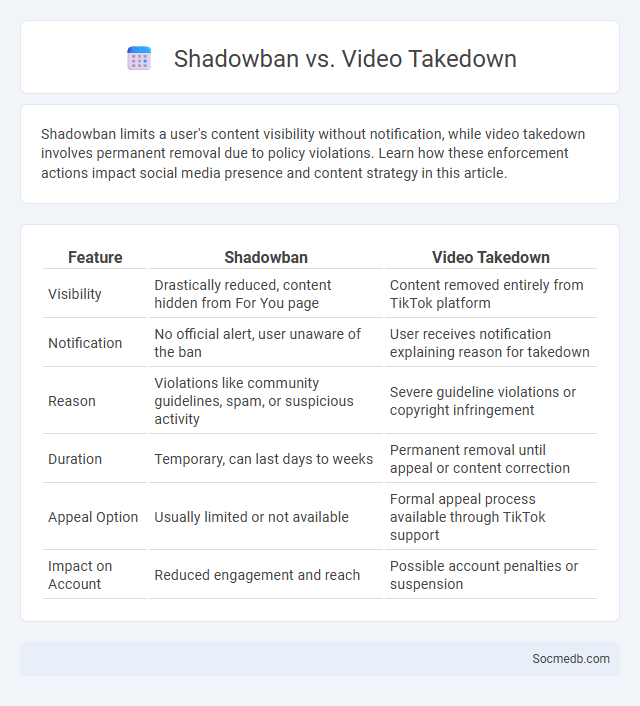
Photo illustration: Shadowban vs Video Takedown
Shadowban limits a user's content visibility without notification, while video takedown involves permanent removal due to policy violations. Learn how these enforcement actions impact social media presence and content strategy in this article.
Table of Comparison
| Feature | Shadowban | Video Takedown |
|---|---|---|
| Visibility | Drastically reduced, content hidden from For You page | Content removed entirely from TikTok platform |
| Notification | No official alert, user unaware of the ban | User receives notification explaining reason for takedown |
| Reason | Violations like community guidelines, spam, or suspicious activity | Severe guideline violations or copyright infringement |
| Duration | Temporary, can last days to weeks | Permanent removal until appeal or content correction |
| Appeal Option | Usually limited or not available | Formal appeal process available through TikTok support |
| Impact on Account | Reduced engagement and reach | Possible account penalties or suspension |
Understanding Shadowban: Definition and Impact
Shadowban is a hidden moderation technique used by social media platforms to restrict a user's content visibility without their knowledge, often by limiting reach or hiding posts from followers. This practice impacts user engagement by significantly reducing organic impressions, making it difficult for content creators to grow their audience or interact authentically. Understanding shadowban involves recognizing its subtle effects on metrics such as likes, shares, and comments, which can plummet without clear explanation.
What is Video Takedown? Key Differences
Video takedown refers to the removal of videos from social media platforms due to copyright infringement, policy violations, or harmful content. Key differences include automated takedown processes driven by AI algorithms versus manual reviews by content moderators, as well as the varying scope of enforcement depending on platform-specific community guidelines and legal obligations. Understanding these distinctions helps creators navigate content management and compliance effectively across platforms like YouTube, Facebook, and TikTok.
Defining Shadowbanning Across Platforms
Shadowbanning is a covert practice used across social media platforms where Your content visibility is intentionally limited without notification, reducing reach and engagement. Popular platforms like Instagram, Twitter, and TikTok employ varying algorithms to restrict posts or accounts deemed in violation of community guidelines or suspected of spammy behavior. Understanding shadowbanning helps You optimize your content strategy and maintain consistent audience interaction despite these unseen restrictions.
Shadowban vs Video Takedown: Core Contrasts
Shadowban restricts your content's visibility without notifying you, causing a drop in engagement while your videos remain live; in contrast, a video takedown removes your content entirely due to policy violations or copyright issues. Shadowbans are often temporary and harder to detect, impacting reach silently, whereas takedowns are explicit and usually come with a platform alert or explanation. Understanding these differences helps you navigate social media compliance and maintain your channel's health effectively.
How Shadowbanning Affects Content Reach
Shadowbanning significantly reduces your content's visibility by limiting its exposure to followers and potential new audiences without any notification. This hidden restriction causes engagement rates to drop as posts fail to appear in feeds, search results, or hashtag pages. Understanding how shadowbanning affects content reach is crucial for maintaining and growing your social media presence effectively.
Legal Implications: Video Takedown vs Shadowban
Social media platforms face complex legal implications when deciding between video takedowns and shadowbans, balancing copyright infringement claims and freedom of expression rights. Video takedown requests often require compliance with laws such as the Digital Millennium Copyright Act (DMCA), whereas shadowbanning raises concerns about transparency and potential violations of users' rights under platform policies. Understanding the legal differences is crucial for content creators and platforms to navigate liability, content moderation, and user engagement effectively.
Detection: Signs of Being Shadowbanned
Shadowbanning on social media can manifest through significant drops in post engagement and visibility without clear notifications. Users may notice their comments are invisible to others or their content fails to appear in hashtag searches and feeds. Monitoring changes in reach analytics and testing content visibility across different accounts helps detect if an account is shadowbanned.
Preventing Shadowban and Video Takedowns
To prevent shadowban and video takedowns on social media, consistently follow platform guidelines by avoiding copyright infringement and community standards violations. Your content should be original, respectful, and free from spammy behavior to maintain visibility and audience engagement. Monitoring analytics regularly helps identify issues early, allowing you to adjust strategies to keep your account in good standing.
Recovery Steps: What to Do After a Takedown or Shadowban
After a takedown or shadowban on social media, start by reviewing platform guidelines to identify the violation. Appeal the decision through official support channels while maintaining consistent, rule-compliant content to restore your account's visibility. Monitor your engagement metrics closely to detect improvements and adjust your strategy to prevent future restrictions on Your social presence.
Platform Policies: Shadowbanning and Content Moderation
Platform policies on shadowbanning and content moderation directly impact your visibility and engagement on social media. Shadowbanning restricts your content's reach without notification, often due to algorithmic detection of rule violations or controversial material. Effective content moderation balances user safety with free expression, enforcing guidelines that shape what content remains accessible while minimizing harmful or misleading posts.
 socmedb.com
socmedb.com